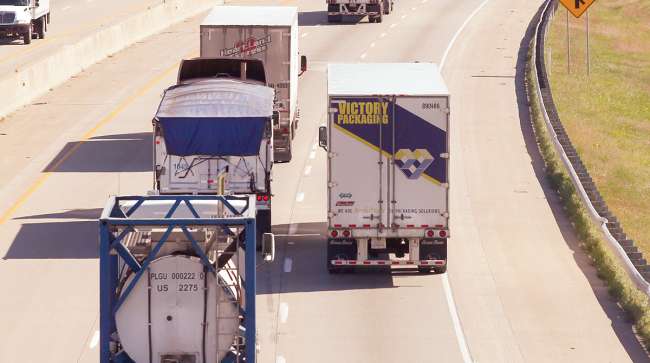Senior Reporter
May Tonnage Rises 3.7% Year-Over-Year

[Stay on top of transportation news: Get TTNews in your inbox.]
Truck tonnage rose 3.7% in May compared with year-ago levels and is pacing well against comparisons to the early months of the coronavirus pandemic, according to American Trucking Associations.
The ATA For-Hire Truck Tonnage Index equaled 113.7 in May, according to a June 22 news release. When measured against April, the index decreased 0.7% for the month. For purposes of the index, 2015=100.
Through the first five months of 2021, the index is up 0.4% compared with 2020, which is significant considering freight volumes during the year-ago time frame, said ATA Chief Economist Bob Costello. “Tonnage, despite falling slightly over the last two months, remains well above the lows of last year,” he said. “This is no small deal considering that truck tonnage fell significantly less than other indicators during the depths of the pandemic in the spring of 2020.”
“One freight segment that is helping tonnage is gasoline demand for travel, both commuting and vacation-related pickups,” Costello added. “I am also expecting retail freight to remain robust as inventories are at historic lows.”
Costello said in the near term freight will remain strong, but the industry is facing some significant challenges.
“As retail stocks are rebuilt, it will boost freight,” he said. “As has been the case for some time, trucking’s biggest challenges are not on the demand side, but on the supply side, including difficulty finding qualified drivers.”

Costello
Meanwhile, the monthly Logistics Managers Index in May recorded 71.3, up from 54.5 last year when available capacity was high and prices were low amid the COVID-19 pandemic. The May reading was down from April’s 74.5, but the report said it still indicates significant growth.
This was the seventh month in the last nine the index reached into the 70s, a streak that has kept it above the all-time average of 63.3.
“This hard shift in economic activity is akin to going from standing still to a full sprint, and as would be expected, it has put tremendous pressure on supply chains,” Arizona State University professor Dale Rogers said. “Many supply networks are currently suffering from the phenomenon known as the ‘bullwhip effect’ in which smaller variations in demand at the consumer level lead to wild swings further up the chain.”
Rogers emphasized the improving economy is putting extreme pressure on the trucking industry and believes that the driver shortage is likely to remain one of the industry’s toughest challenges for some time to come.
“Truck drivers remain difficult to hire for a number of reasons, including the lack of students coming out of truck driving schools during COVID, the crackdown on drivers through the Drug and Alcohol Clearinghouse, ongoing unemployment benefits and heightened levels of savings built up during COVID,” Rogers said. “The desperation for truck drivers is getting to the point where multiple carriers are offering salaries well above $200,000.”
The report is authored by business and logistics professors from Colorado State University, Arizona State University, Rutgers University, Rochester Institute of Technology and the University of Nevada-Reno.
The IHS Markit Flash Composite Purchasing Managers Index released June 23 was 63.9 compared with 46.8 in May 2020. The new June number was lower than May’s 68.7, a level that the authors said marked a two-month low. However, they noted there is a substantial expansion in private sector economic activity, even as delivery delays slow manufacturing growth.

Over the past 15 months, the COVID-19 pandemic has caused a consumer shift toward e-commerce, creating new challenges for the supply chain. Host Seth Clevenger speaks with Mark Manduca, chief investment officer for XPO's contract logistics segment, which will soon become a stand-alone company, GXO. Hear a snippet above, and get the full program by going to RoadSigns.TTNews.com.
“Although price gauges have also slipped from May’s all-time highs, it’s clear that the economy continues to run very hot,” IHS Markit Chief Business Economist Chris Williamson said in a statement. “Prices charged for goods and services are still rising very sharply, record supply shortages are getting worse rather than better, firms are fighting to fill vacancies, and manufacturers’ warehouse stocks are being depleted at a worrying rate as firms struggle to meet demand.”
The Cass Freight Index in May showed the trucking industry economy is booming. The index measured 1.269, up 35.3% from last May’s figure of .938. “A very strong year-over-year result was expected against an easy comparison amid the pandemic shutdown, but the acceleration was ahead of expectations against a similar comp to April,” the report said. The May figure was the second-best result in the index’s history, behind only May 2018.
The Portland, Ore.-based DAT Truckload Volume Index fell to 212 last month, 6% less than April but still the fourth highest month on record. Spot truckload freight rates hit record highs in May despite a month-over-month decline in volume, a sign that transportation networks are not growing fast enough to keep up with consumer demand. Monthly average spot van, refrigerated and flatbed rates set record highs and refrigerated and flatbed rates are topping $3.00 a mile, for the first time. The national average reefer rate was $3.11 per mile, up 18 cents compared to April. The flatbed rate averaged $3.13 a mile, a 17-cent increase month-over-month.
Want more news? Listen to today's daily briefing below or go here for more info:




